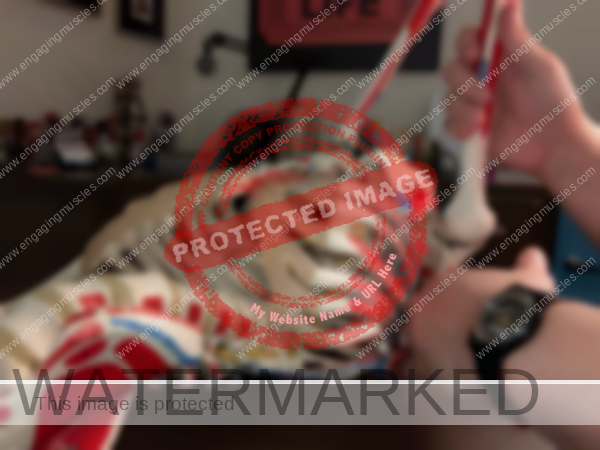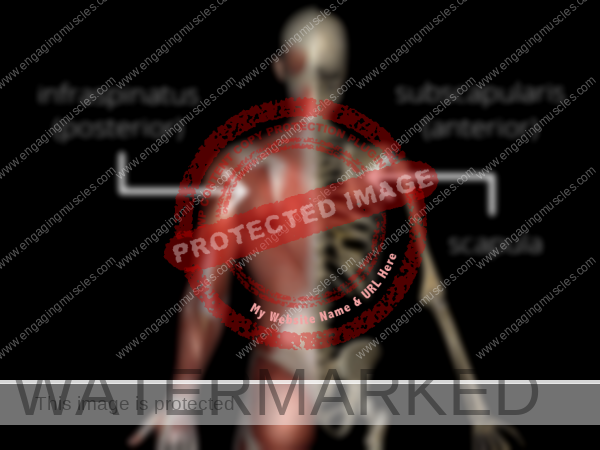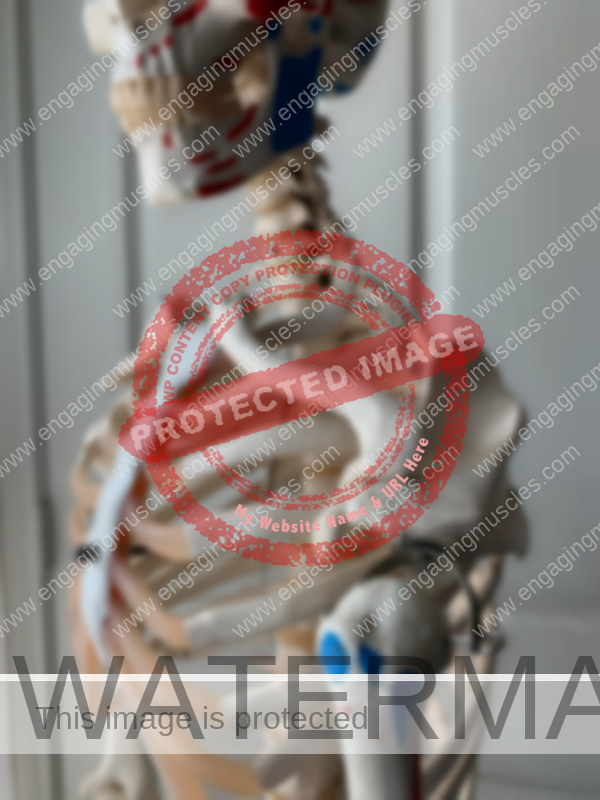Your subscapularis is one of four muscles that make up a group of muscles called the rotator cuff.
Your subscapularis and two of its closest friends from the same group of rotator cuff muscles are major players for rotation of your arm.
A close-knit group, your rotator cuff muscles are the main contributors to the stability of your shoulder.
To play their role to the best of their ability, your rotator cuff muscles need many other muscles to contribute to stability.
As important as your subscapularis is to shoulder function, pain rarely comes down to one muscle.
I feel that’s worth mentioning. Because regularly, practitioners jump to the conclusion that one muscle is the reason for the pain.
Shoulder pain? It’s a rotator cuff muscle. Neck and shoulder? The focus is on where the “knot” is located. Hip pain and sciatica? Your piriformis gets the blame.
Meanwhile, the piriformis muscle is rarely tight.
(Perspective)
As far-fetched as this may seem, I would argue that not doing anything is better than releasing muscles and stretching. That’s also the case with the conventional ways experts choose to strengthen the subscapularis and surrounding muscles.
Attempting to strengthen a muscle that’s not capable of pulling (read: generating tension) at the right time and in the right direction allows the weak muscles to remain weak. Rather than strengthening the subscapularis and the remaining rotator cuff muscles that need it the most, more repetitions encourage even more compensation.
Whereas attempting to release muscles to alleviate pain and muscle tightness increases instability. When you are left to go forward with more instability, you unknowingly end up with more compensation. Going forward (again unknowingly), you are more vulnerable to pain or an injury somewhere down the road.
(Perception)
No matter how you feel about stretching, strengthening, or releasing muscles with deep tissue massage, your brain is going to find the path of least resistance. Then, you are left with what’s known as a false sense of stability.
Because the popular approaches to addressing pain aren’t aligned with principles, it’s not uncommon to feel worse than before muscles were released. It’s also not uncommon to feel worse after spinal adjustments (hint, hint).
Whatever the approach may be, chalk feeling worse up to luck that didn’t go in the way of the practitioner that day.
While it’s possible to release your subscapularis and experience relief for a few hours, what goes unrecognized is that you are left with more instability. And more instability leads to more compensation.
The truth is you can’t have more mobility or flexibility without stability.

While it’s rarely acknowledged by practitioners who work with the musculoskeletal system, the truth is MOST pain is due to instability.
For this reason, I look far and wide for positions of instability that impact shoulder function.
Massage Tutorial for Upper Back | How to Palpate Subscapularis Muscle
Your arm can reach over a thousand different positions at your shoulder joint. That’s a lot of positions that your subscapularis and many other muscles are responsible for stabilizing.

The depth of the four muscles that make up your rotator cuff puts them closer to your shoulder joint than any other muscle. The depth of your rotator cuff muscles and the orientation of their fibers also makes them well suited for the role of providing stability.
When your brain doesn’t recognize stability in certain positions, you’ll experience pain.
Pain is the harm alarm. And instability is what triggers it to sound off.
If you have been trying to figure out why you continue to experience pain in your shoulder, the first thing worth knowing is that ball and socket joints come in different shapes and sizes.
As an example, your hip has a relatively deep socket. Whereas the joint surface on your shoulder blade (read: scapula) is shallow. (See image below.)

Close to 90% of the motion available to you right now is because of synovial joints. The ball and socket at your shoulder is the synovial joint that allows for the most mobility.
Given the joint structure’s nature, it takes an army of muscles to stabilize the body’s most unstable joint. If those muscles could speak up for themselves, they would tell you that releasing and stretching are increasing the amount of instability and compensation.
Going by feel can have you thinking that your ladder is leaning against the right wall. Because releasing muscles with deep tissue massage and stretching feels good at the time, it’s easy to think that you are gaining ground on muscle tightness.
With more mobility, you’re going to have less stability, which is why releasing muscles is extremely unproductive.
(Principles)
When it comes to human function, it’s worth recognizing that everything is connected in more ways than one.
For instance, if you play golf with orthotics underneath your feet, the timing at which your joints move will be thrown off from the top-down and the bottom-up. Because orthotics and overly supportive shoes throw off the starting position of your feet, when you swing, energy leaks and restricted motion extend all the way out to your shoulders.
More repetitions with arch support that’s coming from outside of your body stress your shoulder.
Before you make important decisions that could have a major impact on your health over the long term…
“Consider the source’s worldview.”
— Douglas Vigliotti, author of The Gap – The Little Space Between What You Know and Don’t Know
You can only have second-layer knowledge in so many areas. You can’t know all there is to know about every subject that’s worth knowing.
When dealing with pain, it pays to set the ego aside and acknowledge the gaps in knowledge. Get to that place, and you’ll save yourself a lot of time and frustration.
If you don’t understand the role of your subscapularis or any other muscle, it’s unlikely that you could spot a practitioner who’s working from a place of knowledge debt.
There’s surface layer knowledge, first-layer knowledge, and second-layer knowledge. Because second-layer knowledge is much more difficult to obtain – it’s extremely rare!
If you don’t have second-layer knowledge regarding human function, it’s easy to fall for surface-layer knowledge and first-layer knowledge.
If luck doesn’t land in your favor, you’ll still have pain.
When combinations of stuff that address symptoms are thrown at the pain, there’s a slight chance you’ll walk away from the experience with no pain.
If we are honest, after seeing a specialist that ignores the amount of stability that can only come from muscles, MOST people still experience pain and symptoms.
But that’s not the story that most people who seek help from a specialist tell themselves.
Since we are on the subject of luck, it’s worth recognizing that expectations and placebo are at play.
Expectations and placebo will never increase stability. And increasing stability is what gets to the source.
Pain isn’t the only measurable worth measuring.
If you are dealing with shoulder pain, there’s a strong possibility that a foot specialist isn’t thinking about the long-term ramifications on your shoulder.
Along the same lines, it’s doubtful that a shoulder specialist will consider the environment of your feet. That would also be the case with a back specialist. Although some back pain specialists recommend “custom” orthotics and claim they will help with alignment. Then, your right back to getting regular spinal adjustments that allow for nothing more than a placebo (and compensation).
MOST shoulder specialists fail to recognize that muscles have to anchor off of something stable. If they happen to pay attention to muscles, the way they determine a tight muscle from a weak muscle is severely flawed.
If you were aware of what you just read, you might not turn to surgery and other invasive procedures.
You would be under the impression that you had explored all of your options. Pain is a driver. And so is the complexity that’s used to confuse.
“In our daily lives, we’re often guessing about the facts based on hints, hunches, bias, misinformation, and the like.”
— Scott Adams, Creator of Dilbert and the Author of Loserthink
To provide stability, your subscapularis and the surrounding muscles have to supply the internal force at the right time, in the right plane, and at the right joint.
Your subscapularis and all of its friends can get to a point where they aren’t capable of playing their role to the best of their ability.
You have many muscles that cross your shoulder joint. It only takes one that isn’t capable of pulling (read: generating tension) at the right time.
Then, you’ll have tight muscles trying their best to make up for what the sluggish muscle isn’t capable of providing.
Throughout the years, whenever I described this scenario to patients, their response has often been, “That makes sense.”
While it may make sense, it’s important to recognize that MOST practitioners regularly go after tight muscles.
Not only are tight muscles the symptom, but they also aren’t as bad as surface-layer knowledge and first-layer knowledge has led you to believe.
SHIP.
(Art)
Can’t get to Dallas? Get details on how you can work with me from home.
Thanks for taking the time to read this post! If you enjoyed this post, please subscribe to Engaging Muscles. You can also like Engaging Muscles on Facebook, subscribe to my YouTube Channel, or feel free to connect with me on Twitter @rickmerriam.
[Some of the links I’ve shared with you are affiliate links. If you make a purchase using one of these links, I will receive a commission. The commission doesn’t cost you any more than what you would pay for these items on Amazon (as an example). When you use any one of these affiliate links, you’re supporting the Engaging Muscles blog. That’s also the case with the Engaging Muscles podcast. This helps me to keep putting out valuable content.]
